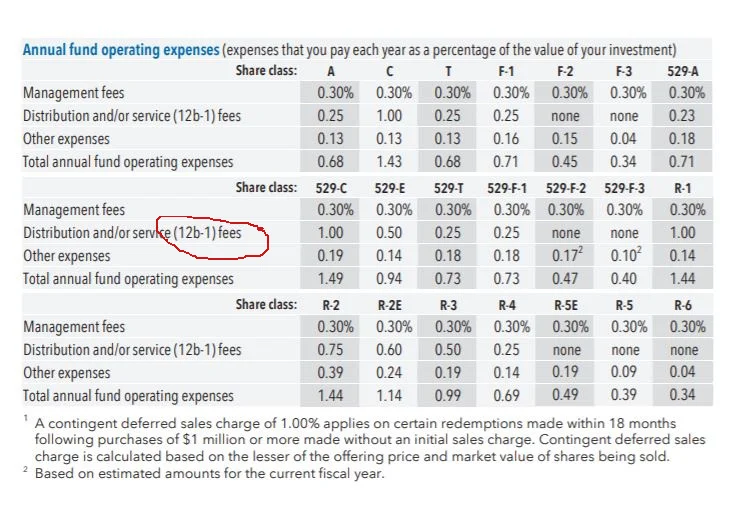Why 12b-1 fees take a big bite of your portfolio!

If you are buying mutual funds, we believe you should avoid paying 12b-1 fees at all costs; they bite off a bigger part of your wealth than you are probably realizing. In this blog we’ll talk about what these charges are, the impact they could potentially have on your portfolio, and how to tell how much in 12b-1 fees you are likely paying.
What is a 12b-1 fee?
A 12b-1 fee is essentially the fee you are charged for someone selling you a mutual fund. 12b-1 fees are charged to cover the expense of advertising, shareholder servicing, marketing collateral, prospectuses, and commissions paid by the issuing firm to the salesperson who sold the shares.
It is deducted from the mutual fund’s assets as an operational expense, driving up the fund’s expense ratio. The fund then awards a commission directly to the broker who sold the mutual fund to the investor.
How to find out how much in 12b-1 fees you are paying
12b-1 fees are disclosed in the mutual fund’s prospectus (which you can find online). Most of the time you are able to find them in the summary prospectus.
Check out the shareholder fees section. Sometimes they lump in the 12b-1 with other distribution fees, but at least you will get a sense of roughly what you are paying for the fund to market itself. Here is an example from the American Funds AMCAP® Fund.

Fee layering can be lethal to your portfolio
As a financial advisor in Philadelphia serving clients across the country, we have seen that 12b-1 fees are significant. They can total up to 1% of the fund’s assets but by law it can be no greater than that. Assuming you bought the fund on your own, with no assistance from any type of financial professional, up to 1% of your money would go to the fund automatically in 12b-1 fees. To find out how much you are paying, multiple the fee % by the total amount you have invested in that mutual fund.
But what if you aren’t investing on your own? The exercise becomes quite detrimental to the investor when he or she works with a financial advisor, who charges up to 1.5% annually for his or her services. Many advisors place their clients’ money into mutual funds.
For the purposes of illustration, let’s say you are paying your financial advisor 1.5% annually.
- Your advisor invests your entire portfolio into mutual funds with a 0.75% 12b-1 fee.
- You are now getting charged, effectively, 2.25% fees on your wealth.
- You may also have to pay transaction costs for that trade.
Takes quite a bite out of the pie, doesn’t it?
Let’s talk about why.
Fees destroy investor wealth
The impact of fees on a portfolio over time is immensely destructive. They may sound like just a small percentage of your wealth, but they add up over time.
As we’ve discussed in other blogs on how fees impact your money, if you had a $1MM portfolio returning 6% annually on which you were paying a 1.5% fee to a financial advisor, you’d have over $3.75M over 30 years. However if you were to reduce that 1.5% fee down to 1%, you would have saved over $570k.
Costs matter, and higher fees are not necessarily correlated with higher value to the investor. Any time you are paying out of your portfolio for any type of financial service, whether it be a financial advisor or a financial product such as a mutual fund, you should ask yourself if there are lower cost options available that will accomplish your goal satisfactorily. 12b-1 fees should be subject to this analysis.
Why we are a financial advisor who only uses ETFs
In our wealth management practice, we made the decision to bypass 12b-1 fees by foregoing the use of mutual funds altogether.
- Flexibility – you can buy or sell at any point during the day, as opposed to a mutual fund that is transacted only at close of business
- Diversification – ETFs can be used to help eliminate unsystematic risk
- Tax efficiency – ETFs have low turnover and do not sell holdings in exchange for cash, as a mutual fund does.
If you would like to learn more, read our piece about the benefits to ETFs. Many financial advisors are able to create efficient portfolios in accordance with your risk tolerance without the use of high-cost mutual funds.
To read more about low cost investing, consult our blog and other resources on this site.
We are a fiduciary financial advisor in the Philadelphia area, but we work with clients across the country. We provide fee-only, objective advice to our clients. If you would like to discuss a possible relationship, contact us.
Sources
Capital Group/American Funds. Forms & Literature. Summary prospectus - AMCAP Fund. Retrieved on February 8th, 2022 from here
